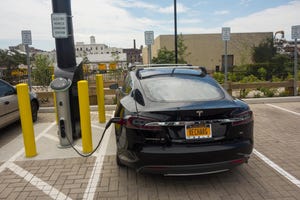
It's 2027, and generative AI is rampaging. Millions of jobs have been lost to the technology, while fewer have been created. Companies employ legions of "no coders" as software handlers and quality-control experts, charged with removing hallucinations like broken parts from a factory line. Education is in disarray. Students fire off AI-generated essays and zone out.
Mass-market usage proves computationally intensive for the world's biggest data centers, forcing owners to invest billions in AI chips, software development and the construction of new facilities. As their profit margins are squeezed, they club together and demand a fair share or contribution from telcos. Last-mile networks, they argue, are the ultimate source of the billions of generative AI queries that put so much pressure on data-center infrastructure each day.
Figure 1: Mobile revenues versus traffic  (Source: Omdia)
(Source: Omdia)
This fictional reversal of the ongoing fair share debate is not infeasible, judging by one telco's assessment of ChatGPT's impact on networks (relatively minor, compared with high-definition video) and data centers (where generative AI requires a huge amount of processing power, especially during the training phase). The telco executive who spoke with Light Reading requested anonymity but is a senior member of the company's AI team.
Such demands would be no more illogical than the telco insistence today that a handful of Big Tech firms should contribute to network costs because they are largely responsible for the recent traffic surge. Omdia (a Light Reading sister company) forecasts a 219% increase in petabytes carried on mobile networks each year between 2022 and 2027. It predicts annual revenues will grow only 14.6% over the same period. A neat chart shows petabytes catching up with and threatening to submerge revenues like a giant wave.
Mistaken assumptions
It has been seized on by a senior executive at Ericsson as evidence the telco business model "needs to change." The assumption, then, is that a traffic surge is a negative, implying a drop-off in petabytes would be a positive. Yet customers are unlikely to spend as much on network services if they are out socializing or being sporty, rather than hooked to their smart gadgets – let alone upgrade to the pricier, higher-speed networks marketed so furiously by telcos and their vendors.
This assumption traffic growth is bad seems based on the idea it adds cost for telcos. But the industry has done a poor job of showing how. Indeed, the argument that generative AI will be expensive for data centers is far more convincing. To start, rising data costs for telcos should be reflected in the greater electricity use. Yet, energy consumption by four of Europe's biggest telcos has either declined or remained stable in recent years. Loading traffic onto the network has not driven up energy costs.
Figure 2: Energy use in gigawatt hours  (Source: companies)
(Source: companies)
(Note: Data for Vodafone is unavailable before 2018)
Operators say that is only because newer technologies are far more energy efficient. For every terabyte of network data, 4G consumes 35% as much energy as 3G, while 5G uses only 7% as much, said Andrea Dona, Vodafone UK's chief networks officer, at a press briefing last week. But he also claims Vodafone has now "decoupled" data traffic growth from energy consumption. He is optimistic about lowering energy use in the future as older network technologies are ditched.
As for the upfront outlay on new and more energy-efficient technologies, capital intensity (spending as a percentage of revenues) is highest at telcos when they invest in coverage, not capacity. It has certainly not been out of control while Europe's operators expand their 5G networks, either. A sharp increase at BT since 2017 is linked mainly to the rollout of fiber, which means digging up streets to lay cable.
After that job is done, future upgrades should involve the less costly installation of new boxes at either end of the line. Copper networks have been around for a century, and there is every chance fiber's life expectancy will exceed even this. Telefónica, far ahead of BT on fiber rollout, saw capital intensity drop from 17% in 2016 to 15% in 2022. It expects a figure of 14% this year.
Despite all this, financial analysts say many European operators do not cover their cost of capital. UK authorities seem to agree with them regarding Vodafone UK and Three, two of the country's four mobile operators. But the British government this week linked that problem to the high number of UK networks, not a petabyte surge. The implication is that allowing Vodafone and Three to merge, as they propose, would resolve the matter.
After the government's intervention, a deal of some nature seems likely to go ahead. That would stoke the usual concerns about price rises and job losses, but it should also boost returns, according to equity analysts and government logic. If that happens, any bleating about fair share will be even harder to back up.
Related posts:
— Iain Morris, International Editor, Light Reading
Read more about:
EuropeAbout the Author(s)
You May Also Like












